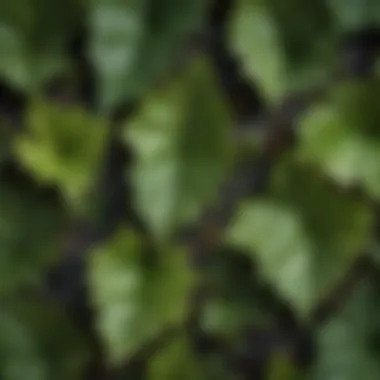Identifying Poison Ivy: Key Traits and Health Impact


Overview of the Topic
Poison ivy, a common yet often misunderstood plant, holds significant relevance in the realms of ecology and human health. It belongs to the Toxicodendron genus, which also includes poison oak and poison sumac. Understanding its characteristics is crucial for anyone involved in outdoor activities, environmental science, or even general bushcraft. The plant possesses particular traits that make it both distinctive and harmful.
Recognizing poison ivy can help prevent the unpleasant skin reactions it causes, typically characterized by itching, redness, and inflammation. Furthermore, poison ivy plays an integral role in its ecosystem, serving as habitat and food source for various wildlife, thus adding complexity to its perception.
Prelude to the Key Natural Resource
The conversation around poison ivy extends beyond its negative health effects. In many regions, it thrives in diverse habitats, from forests to urban areas, demonstrating adaptability and resilience. It plays a role in soil stabilization, helping to prevent erosion. This understanding is important as we address human interaction with local flora and fauna.
Background Information on the Significance of the Topic
Poison ivy's prevalence across North America and its proximity to human activities underscore the importance of education about this plant. For conservationists and environmentalists, appreciating the duality of its function—as both a natural resource and a health hazard—becomes essential. Equip oneself with knowledge about its identification and management to foster a smarter coexistence with this plant.
Current Status and Challenges
Currently, the battle against poison ivy's encroachment is ongoing. Even as public awareness improves, many still struggle to identify it correctly, leading to instances of contact. The challenge lies in its deceptive similarity to harmless plants, such as Virginia creeper and other ivy species.
Examination of the Current State
The environmental conditions that favor poison ivy's growth are becoming more pronounced, partly due to climate change. Warmer temperatures and heightened CO2 levels facilitate increased growth rates and potency of the plant's urushiol oil, which is responsible for allergic reactions.
Identification of Challenges and Threats
In addition, it faces limited educational engagement within communities. Many individuals remain unaware of its harmful effects, which risks both personal health and ecological balance. The misconception often stems from the lack of visible damage it may seem to inflict on the environment compared to other invasive species.
Sustainable Solutions
Addressing the challenges of poison ivy involves an informed approach to management and prevention. Education is key, allowing individuals to identify the plant and understand its effects. Workshops and local programs can foster awareness, particularly in communities heavily affected by outdoor activities and urban development.
Exploration of Sustainable Practices
Proactive measures include:
- Educational campaigns: These can provide information on identifying poison ivy.
- Community workshops: Encouraging local volunteers to participate in teaching others about the plant.
- Research initiatives: Focusing on the ecological importance of poison ivy while also promoting safe interaction with it.
Showcase of Successful Case Studies
For example, in certain parks, controlled removal efforts have engaged volunteers, effectively reducing the presence of poison ivy. These initiatives not only keep communities safe but also nurture a sense of responsibility towards local ecosystems.
Impact and Importance
Poison ivy's impact on ecosystems is multifaceted. As a native plant, it supports various forms of wildlife, which depend on it for both food and habitat. It embodies the intricate balance within nature where offense and defense exist side by side.
Analysis of the Impact
The importance of understanding poison ivy extends to future generations. With environmental changes, its potential spread raises concerns. Conservation efforts must evolve to address not only the safety of individuals but also the health of interlinked ecosystems. Education on sustainable resource management remains vital, fostering respect for all components of nature, including those that provoke discomfort.
"Knowledge of one’s environment leads to an empowered community capable of making informed decisions"
Overview of Poison Ivy


Poison ivy is a plant that many encounter during outdoor activities. Understanding its characteristics is vital not just for environmental awareness but also for personal health. This section provides a foundation for the reader, focusing on the biological, ecological, and health implications of poison ivy.
Botanical Classification
Poison ivy belongs to the family Anacardiaceae, which includes other notable plants like cashews and mangoes. Its scientific name is Toxicodendron radicans. This classification is essential because it informs the public about the plant’s potential dangers. Species in the Anacardiaceae family can cause allergic reactions, making it crucial to distinguish poison ivy from other plants even within the same family.
Understanding its botanical classification helps in identifying the plant and recognizing its behavior within various ecosystems. The plant may be found in various forms: as a vine, shrub, or ground cover. Each of these forms can be encountered in different environments, affecting how easily they can be identified.
Geographical Distribution
Poison ivy is primarily found in North America, extending from southern Canada to northern Mexico. It thrives in various habitats, including forests, wetlands, and fields. Knowing where poison ivy grows is crucial for prevention. Its adaptability allows it to flourish in disturbed sites, such as roadsides and gardens.
The plant's geographical distribution is a significant factor in its ecological role. Furthermore, different regions exhibit variations in its growth patterns. This knowledge can assist conservationists and environmentalists in translating their outdoor experiences into informed decisions regarding their safety and the environment they traverse.
Poison ivy's widespread presence demands a refined understanding of its characteristics for public health and ecological integrity.
Characteristics of Poison Ivy
Understanding the characteristics of poison ivy is crucial for both recognition and avoidance of this plant. Poison ivy, scientifically known as Toxicodendron radicans, has distinct features that can prevent exposure and its consequent reactions. By being familiar with poison ivy's physical traits, people can safeguard themselves when traversing natural areas. This section delineates the essential characteristics, making it a vital part of comprehending the impact of poison ivy.
Leaves: Structure and Color
The leaves of poison ivy are one of its most recognizable traits. They typically grow in groups of three leaflets, which is a hallmark feature. The individual leaflets are often pointed at the tip and round or lobed at the base. In terms of color, young leaves emerge with a reddish tint that often changes to a rich green as the summer progresses.
In the fall, the leaves can turn a beautiful array of colors, including yellow, orange, and red. It is important to note that people often remember the phrase "leaves of three, let it be" as a simple guideline for identification. This phrase underscores the need to remain cautious when observing plants that fit this description.
Stems and Vines
Poison ivy can manifest in various forms. It can grow as a low shrub, a climbing vine, or even a spreading ground cover. The vines are particularly notable for their hairy appearance, which can often be seen when the plant climbs up trees or fences.
The stems can vary in thickness, adding to the complexity of recognizing poison ivy. Notably, when examined closely, the stem has a distinctive reddish hue during certain times of the year. This variation can help differentiate poison ivy from other similar plants. Furthermore, people's persistent awareness of these characteristics is essential, especially in outdoor activities or gardening.
Flowers and Fruits
In addition to its leaves and vines, poison ivy produces small greenish flowers that cluster together. These flowers bloom in late spring to early summer. They have a modest appearance and may often go unnoticed amid the foliage.
After flowering, poison ivy generates white or yellowish berries that are small and round in shape. Birds, along with other wildlife, are attracted to these berries, which can lead to unintentional propagation of the plant. Knowing about the flowering and fruiting patterns can aid in recognizing poison ivy throughout the growing season and provide clarity about its reproductive cycle.
Being aware of poison ivy's characteristics is not merely an academic exercise; it is key to personal safety in nature.
In summary, the features of poison ivy are not only distinctive but also play a critical role in promoting understanding and caution while in its presence. Recognizing these characteristics enables individuals to navigate natural environments more effectively, mitigating unnecessary exposure.
Distinguishing Features
Understanding the distinguishing features of poison ivy is crucial. This knowledge allows individuals to identify the plant correctly and avoid exposure. Poison ivy can cause severe skin reactions. Therefore, recognizing its unique traits is vital for safety. Failure to do so can lead to painful rashes and other health impacts. In this section, we will explore its three-leaf structure, seasonal variations, and its resemblance to similar plants.
Three-Leaf Structure
The most defining characteristic of poison ivy is its three-leaf structure. Each leaf can be oval or pointed at the tip. They tend to have smooth or slightly serrated edges. This arrangement leads to the common phrase "Leaves of three, let it be." The leaf arrangement is consistent throughout the growth cycle, which makes it easier to identify the plant.
Misidentifying poison ivy can happen easily due to its appearance. However, the three-leaf structure is a reliable guide for recognition. When spotting the leaves, one must be mindful that they can vary in color depending on the season. However, the number of leaves remains constant. This constant is essential for people to remember when they learn about the plant.


Variations Across Seasons
Poison ivy changes appearance across seasons. In spring, the leaves appear reddish and glossy. As they mature, they turn green throughout summer. During fall, the leaves can become yellow, orange, or even red. These color changes can be confusing but also highlight the plant's versatility. Identifying poison ivy by its seasonal variations helps in recognizing it in different environments.
When studying these changes, one should also consider the growth patterns of the plant. In spring and summer, it can grow as a shrub, climbing vine, or on the ground. In autumn, its changing colors make it stand out among other foliage. Understanding these variations assists individuals in avoiding accidental encounters.
Comparison with Similar Plants
Poison Oak
Poison oak, often confused with poison ivy, has leaves that grow in clusters of three like poison ivy. One key aspect of poison oak is its leaf texture. Poison oak leaves typically have a more lobed appearance, resembling oak leaves. This leafy structure can be beneficial for identification.
While poison ivy leaves are smooth, poison oak leaves are often hairy or fuzzy. This unique feature can help differentiate between the two plants. Further complicating matters, poison oak can also form a shrub or vine. Being aware of this variability is vital for those exploring areas where both plants grow.
Poison Sumac
Poison sumac is another plant often mistaken for poison ivy. Its key characteristic is the leaf arrangement. Poison sumac typically has clusters of leaflets that grow in pairs, with one additional leaflet at the end. This differs from poison ivy's distinct three-leaf formation.
Moreover, poison sumac is found mostly in wetland areas rather than dry fields. This geographic distinction can be important. Understanding the environment where each plant thrives aids in effective recognition. Poison sumac can provoke similar allergic reactions as poison ivy, making knowledge of this plant crucial.
Knowledge of these plants contributes to safer outdoor experiences and overall awareness of native flora.
Habitat and Growth Patterns
Understanding the habitat and growth patterns of poison ivy is crucial for effective identification and management. Recognizing where poison ivy thrives can help individuals avoid unwanted contact and potential allergic reactions. The ecological dynamics of poison ivy offer insights into how it interacts with the environment, contributing to local biodiversity and ecosystem health.
Common Locations
Poison ivy is adaptable and can be found in various locations. Its growth is not limited to any specific type of terrain. Here are some common settings where poison ivy flourishes:
- Woodlands: It often grows in forest understories, where it can find partial shade.
- Fields and Open Areas: Open fields provide sunlight which is beneficial for its growth.
- Roadsides and Trails: These areas are ideal for colonization as seeds may travel along with soil disturbances.
- Riverbanks and Wetlands: Moist environments enable poison ivy to thrive due to sufficient water access.
Understanding these locations can help people recognize where to be particularly cautious.
Growth Conditions
Poison ivy prefers specific growth conditions that allow it to flourish. Recognizing these conditions helps in understanding its resilience. Here are key factors influencing its growth:
- Soil Type: Poison ivy prefers well-drained soils but can tolerate various types. Sandy or loamy soils are often ideal.
- Sunlight: It grows in both sunny and shaded areas, allowing it to adapt to various light conditions.
- Moisture: While it can tolerate drought, poison ivy benefits from consistent moisture, especially in the germination phase.
- Temperature: Generally, it thrives in temperate climates with a suitable range of temperatures.
By being aware of these growth conditions, one can better inform themselves about potential encounters.
"Knowing the environment where poison ivy grows is as important as recognizing its distinctive three-leaf structure."
In summary, grasping the habitat and growth patterns of poison ivy contributes significantly to the overall understanding of this plant. It provides useful context for environmentalists, conservationists, and the general public alike in terms of safety and ecological awareness.
Health Impacts of Poison Ivy
Understanding the health impacts of poison ivy is essential for anyone who may come into contact with this common plant. The exposure to poison ivy can lead to significant discomfort and adverse health effects. This section delves into the symptoms experienced upon exposure to poison ivy and outlines the treatment options available. Knowledge about these impacts can prepare individuals to respond effectively and minimize any potential suffering.
Symptoms of Exposure


When a person comes into contact with poison ivy, the primary culprit is a resin called urushiol. This substance is found in the leaves, stems, and roots of the plant. Symptoms can vary based on individual sensitivity to urushiol, but common reactions include:
- Redness: The affected area may start to appear red shortly after contact.
- Itching: A severe, persistent itch often accompanies the redness.
- Swelling: Swelling can occur as the body reacts to the irritant.
- Blisters: In many cases, blisters will form, potentially oozing fluid.
These symptoms typically appear within 12 to 72 hours after exposure and can last for several weeks. In some individuals, severe allergic reactions can lead to extreme swelling or even difficulty breathing if exposed to large amounts of urushiol.
It is important to remember that not everyone reacts to poison ivy in the same way. Some people may experience a mild localized reaction, while others could face a more intense systemic response.
Treatment Options
Addressing the symptoms of poison ivy exposure requires prompt action to alleviate discomfort and prevent complications. Here are some effective treatment options:
- Wash the Area: Immediate washing with soap and water can help remove urushiol from the skin and lessen the reaction.
- Topical Corticosteroids: Creams or ointments containing hydrocortisone can reduce inflammation and itching.
- Oral Antihistamines: Medications like diphenhydramine can help relieve itching and promote sleep if discomfort disrupts rest.
- Cool Compresses: Applying a damp cloth can ease itching and inflammation caused by blisters.
- Oral Corticosteroids: For severe reactions, a doctor may prescribe oral medications to reduce swelling and inflammation.
In cases where symptoms do not improve or worsen, it is crucial to seek medical help. Understanding these treatment options ensures that those affected by poison ivy can manage their symptoms effectively.
Preventative Measures
Understanding how to prevent encounters with poison ivy is crucial for anyone who frequents wooded areas, parks, or gardens. Preventative measures not only minimize exposure but also educate individuals on recognizing this plant, which helps mitigate the risk of adverse health effects correlated with contact. By becoming proficient in identifying poison ivy in its natural setting, individuals can avoid painful reactions and enjoy outdoor activities safely.
Identifying Poison Ivy in the Wild
To effectively avoid poison ivy, one must first learn to recognize it. Key characteristics include:
- Three leaflets: Each cluster typically presents three leaflets, a defining trait. The leaflets can vary in shape from oval to pointed.
- Color variations: In spring, leaves are reddish. Summer brings a vibrant green, while autumn witnesses a shift to shades of yellow and red.
- Texture: The surface of the leaves can be glossy, which contrasts with many other plants in the vicinity.
In addition to identifying the plant's basic features, one should also be mindful of its growth habits. Poison ivy can appear as a vine, shrub, or ground cover, often interspersed with other flora. These factors can make recognition more challenging, but familiarity with its characteristics aids in avoidance.
Protective Clothing
Wearing appropriate clothing is an effective deterrent when engaging in outdoor activities where poison ivy may grow. Protective clothing can include:
- Long sleeves and pants: Covering skin minimizes direct contact with the plant. This is particularly important in areas with denser growth.
- Heavy-duty gloves: Avoid using lightweight materials, as the oils from poison ivy can permeate thinner fabrics.
- Boots and gaiters: These protect the lower legs and feet from accidental brushing against the plant.
When selecting clothing, opt for materials that are easy to wash and resistant to the penetration of allergens. Always remember that washing skin and clothing soon after exposure can help reduce the chances of developing a reaction.
Awareness and Education
Awareness is pivotal in preventing contact with poison ivy. Education plays a vital role in dispersing knowledge about the plant's characteristics and environmental cues. Having discussions or workshops focused on:
- Community training programs: Organizing sessions where experts educate locals about poison ivy and how to identify it enhances community safety.
- Resource abundance: Providing accessible informational materials—like brochures and guides—enables individuals to reference critical details on poison ivy identification and avoidance strategies.
- Online platforms: Utilizing social media and websites like Reddit and Wikipedia to spread awareness can further facilitate the sharing of knowledge concerning this plant.
"Education is not just an asset; it's a necessity for understanding and managing environmental challenges like poison ivy."
The End
In understanding poison ivy, it is essential to recognize both its ecological significance and the health risks it poses. This article offers a comprehensive exploration of its various characteristics, from appearance to habitat. Such details help facilitate better recognition and understanding of this plant, which is critical for conservationists and environmentalists alike.
Recap of Key Characteristics
Poison ivy is identifiable primarily by its three-leaf structure, but it also exhibits distinct features throughout the seasons. The leaves can vary in color, appearing green in summer but often changing to red or orange in the fall. Additionally, poison ivy’s growth patterns, whether as a low shrub or climbing vine, play a role in its identification. While it can resemble other plants, such as poison oak and poison sumac, knowing these specific traits can help distinguish it during outdoor exploration.
Importance of Knowledge and Caution
Awareness of poison ivy is crucial for minimizing health risks. The plant's oil, urushiol, can cause severe allergic reactions upon contact. Understanding how to identify poison ivy, its seasonal variations, and its common habitats can significantly reduce the likelihood of accidental exposure. Furthermore, promoting education around this plant can enhance community safety, particularly for those venturing into nature for conservation or recreational activities.
Knowledge is the first line of defense against the adverse effects of poison ivy.
By synthesizing these elements, one can appreciate the importance of caution and informed awareness when navigating environments where poison ivy may be present.



